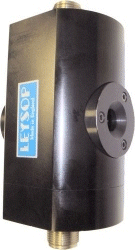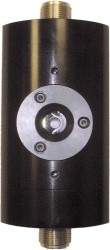For most normal applications such as Q-switching and laser beam modulation, the standard EM500 and EM500M ranges of longitudinal Pockels cells are very adequate. Rise times achievable with these devices can be easily obtained in the range of 500ps and upward with suitable electrical drive waveforms. In fact in most systems, the rise time of the electrical pulse generator into the load capacitance of the cell is the dominant factor and typical rise times are thus of the order of 3 to 5ns.
For some applications, however, the shortest possible rise times are required and this is where our UPC design excels. For pulse picking (selecting one or more adjacent pulses from a high repetition rate train of pulses, especially from a mode locked laser), the rise time requirements are usually based on generating a time gate of a few ns duration, so ~ns rise and fall times are adequate. However, with mode-locked sources often delivering pulse trains of greater than 100MHz repetition frequency shorter time windows are increasingly becoming more common.

For pulse slicing applications, the requirements are more stringent still. Not only are often very short (sub ns) pulses desired, but also the temporal shape of the optical pulse produced must be very clean with no overshot or ringing of the waveform. This requires a Pockels cell which is electrically well matched to the electrical driver source impedance across a wide frequency range. The capacitance of the Pockels cell is then of less importance as transmission line techniques must be used throughout the electrical system.
What makes the Ultra Fast Pockels cells different from other Pockels cells?
First, as mentioned above, the electrical parameters of the cell are matched to a 50W impedance as is to be expected to be found on most ultra-fast rise time drivers. This ensures that the waveform suffers no distortions due to electrical mis-match and cable reflections which could re-open the cell after a short time delay are minimized. Most Pockels cells which use a 50W r.f. type connector for the electrical interface are really only using this type of connector for the convenience (and often safety) which this imparts. For example, our EM500 series Pockels cells use HV BNC connectors which are rated at in excess of 10kV for continuous duty. The internal connections however present slightly too great a series inductance to truly match to 50W. That is not to say that for normal Q-switching duty the response is in any way diminished by the electrical interface, only that when used for ultra-fast switching applications it is possible to resolve internal reflections on the sub-ns time-scale.
The solution used in our UPC is to use a slowly tapered electrode and matched body internal diameter to maintain the impedance as the small input electrical connection is enlarged to interface to the ring electrode of the KD*P crystal. By using this method, a clean electrical interface is presented to the driving circuit and internal reflections are minimized.
It is not however adequate to just ensure that the electrical pulse enters (and exits) the cell quickly. The dielectric constant of KD*P is very high (~50) and so the propagation of the electrical wavefront across the optical aperture is in practice relatively “slow”. Therefore there is a direct conflict between the requirements of fast switching and a large aperture and it is not possible to obtain ultra fast switching in large aperture cells. The UPC still provides a moderately large aperture of approximately 5mm which is obtained by use of a 6mm diameter crystal. This provides a good balance with rise-time which has been measured at <150ps by one of our customers in a “real world” application.
Being made from KD*P, the Pockels cell has excellent transparency over the wavelength range of 0.3-1.2μm and thus is useable with almost all the most important lasers from the UV to the near infra-red. Of particular importance is the region centered at 800nm for use with Ti:Sapphire lasers. Obviously, as wavelengths increase, the voltage required for switching increases linearly and the driver power requirement therefore increases as the square of the wavelength. The cost of high voltage drivers scale at a very similar rate in practice, so techniques to reduce drive voltage are important to reduce system costs. One technique in common usage is to pass the laser beam through the cell twice, thus only requiring a quarter wave switching voltage instead of a half wave. There are obvious limitations to this technique for ultra-short pulse generation, but it may still be useful for pulse picking. A more generally useful approach uses a Pockels cell with two KD*P crystal mounted optically in series, but electrically in parallel such that each crystal only needs to operate to the quarter wave potential (a little less than 4.5kV at 1064nm). Considering the difficulty of generating fast rise-time electrical drive waveforms, it is especially beneficial that the voltage requirements be minimized and therefore the UPC is available in both single and double crystal versions.
View Interface Drawing for both devices
Application Notes for Pockels Cells:
The Linear Electro-Optic Effect
Selecting the Right Pockels Cell
Setting Up the Q-Switch
Pulse Slicing with Pockels Cells
Pulse Picking with 4 Terminal Pockels Cells

